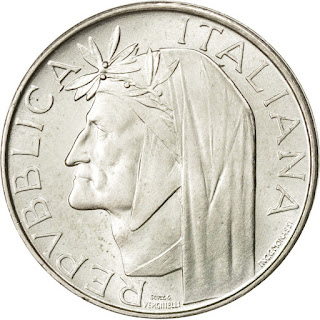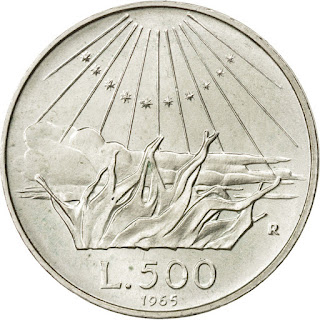Italy 500 Lire Silver Coin 1965 Dante Alighieri
Commemorative issue: celebrating the 700th Anniversary of the birth of Dante Alighieri
Obverse: Head of Poet Dante Alighieri facing left. On his head a lauerel crown. Below the name of engraver and author on two lines.
Lettering: REPVBBLICA ITALIANA SCULT G • VERGINELLI INC • G • MONASSI.
Engraver: Goffredo Verginelli.
Reverse: Flames surmounted by clouds and sun rays with 10 little stars within; allegorical symbols of Hell, Purgatory and Paradise (the three books of the trilogy of the Divine Commedy, a masterpiece of world literature). In exergue indication of the value, under which lies the date. Right of the flames the mint mark.
Lettering: R L. 500 1965.
Engraver: Guerrino Mattia Monassi.
Edge: Inscription in relief.
Lettering: 7° CENTENARIO DELLA NASCITA DI DANTE.
The coin has been minted in 4.272.000 examples.
Value: 500 Lire (500 ITL).
Metal: Silver (.835).
Weight: 11 g.
Diameter: 29.3 mm.
Shape: Round.
Dante Alighieri
Durante degli Alighieri, simply called Dante (c. 1265–1321), was a major Italian poet of the late Middle Ages. His Divine Comedy, originally called Comedìa (modern Italian: Commedia) and later christened Divina by Boccaccio, is widely considered the greatest literary work composed in the Italian language and a masterpiece of world literature.
In the late Middle Ages, the overwhelming majority of poetry was written in Latin, and therefore accessible only to affluent and educated audiences. In De vulgari eloquentia (On Eloquence in the Vernacular), however, Dante defended use of the vernacular in literature. He himself would even write in the Tuscan dialect for works such as The New Life (1295) and the aforementioned Divine Comedy; this choice, although highly unorthodox, set a hugely important precedent that later Italian writers such as Petrarch and Boccaccio would follow. As a result, Dante played an instrumental role in establishing the national language of Italy. Dante's significance also extends past his home country; his depictions of Hell, Purgatory, and Heaven have provided inspiration for a large body of Western art, and are cited as an influence on the works of John Milton, Geoffrey Chaucer, William Shakespeare, and Lord Alfred Tennyson, among many others. In addition, the first use of the interlocking three-line rhyme scheme, or the terza rima, is attributed to him.
Dante has been called "the Father of the Italian language". In Italy, Dante is often referred to as il Sommo Poeta ("the Supreme Poet") and il Poeta; he, Petrarch, and Boccaccio are also called "the three fountains" or "the three crowns".

